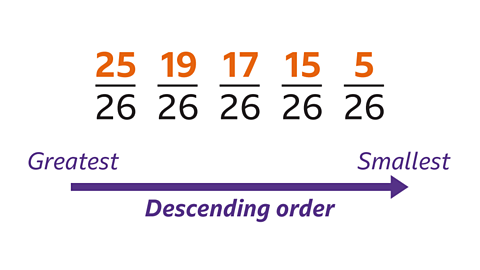Key points
- A fractionThe result of one integer divided by another. It is written with one integer above the other with a horizontal line between them. The denominator must not be 0 is part of a whole, eg 15 minutes is a quarter of a whole hour.
- A fraction is shown by writing one whole number above another. It can also be shown by a diagram.
- The numeratorNumber written at the top of a fraction. The numerator is the number of parts used. Eg, for 1тБД3, the numerator is 1 is the top number. This is the number of parts selected or shaded.
- The denominatorNumber written on the bottom of a fraction. The denominator is the number of equal parts. Eg, for 1тБД3, the denominator is 3 is the bottom number. This is the number of parts the whole has been split into.
What are fractions?
- A fraction is a part of a whole. It is named according to the number of parts the whole is broken up into.
- Fractions split into two, three and four parts are given specific names. These are a halfOne of two equal parts., a thirdOne of three equal parts., and a quarterOne of four equal parts..
- Fractions must be split into equally sized parts. In a diagram each part is the same size. The shaded fraction and the unshaded fraction make up the whole diagram.
Example: fraction diagrams
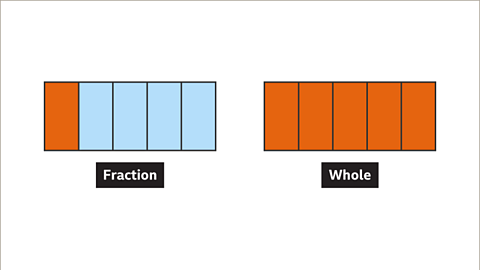
Image caption, A fraction is part of a whole.
Image caption, The whole is split into five equal parts. One part is shaded orange. This is one fifth.
Image caption, Two parts are shaded orange out of five equal parts. This is two fifths.
Image caption, Each of these shapes have been split into two equal parts. Each part is a half. Half is shaded orange and half is unshaded.
Image caption, Each of these shapes have been split into three equal parts. Each part is a third. One third is shaded orange and two thirds are unshaded.
Image caption, Each of these shapes have been split into four equal parts. Each part is a quarter. One quarter is shaded orange and three quarters are unshaded.
1 of 6
Video
Fractions are useful in music.
Watch the video to hear Berry discuss how fractions help her band to perform well together and can affect the feel and rhythm of different songs.
Bobby: So, youтАЩre a musician?
Berry: Yeah, IтАЩm a bassist in a band called Red Ivory.
Bobby: And how did you get into music?
Berry: Well, IтАЩve always loved listening to music and I started playing with my friends around two years ago.
Bobby: Ah, so when you play together, how do you make sure what you play actually sounds good?
Berry: Well, we have to stay in time with each other and depending on the time signature, that can differ from song to song. We often play in a 4/4 time signature.
Bobby: Can you explain what you mean by that?
Berry: A 4/4 time signature has four beats in a bar.
Bobby: So, each beat is one note?
Berry: No, you can have more notes in a bar. You can have half notes and quarter notes, and so on. I think it would be easier if I demonstrate it.
Bobby: Yes, please.
Berry: So here, I can do one whole note which would be тАж
(ONE GUITAR STRUM, FOUR FOOT TAPS)
And then I can do a half note, which would be тАж
(TWO GUITAR STRUMS, FOUR FOOT TAPS)
And then I can have a quarter note, which would be тАж
(FOUR GUITAR STRUMS, FOUR FOOT TAPS)
Bobby: Thank you, so if youтАЩre playing notes of different lengths, how does that change the music?
Berry: Having longer, less frequent notes can create a more relaxed feeling for the song, whereas faster and a lot more notes can create a very intense feeling for the song.
Bobby: Ah, so fractions and maths are an important part of your music?
Berry: Yeah, definitely.
Writing and recognising fractions
- A fraction can be shown by a diagram split into equal parts.
- Fractions are written symbolically as one integerIntegers are numbers with no fraction or decimal part. They can be positive, negative or zero. 42, 8, and 10000 are examples of integers. vertically above another.
- The top number is the numeratorNumber written at the top of a fraction. The numerator is the number of parts used. Eg, for 1тБД3, the numerator is 1. This gives the number of parts shaded or selected.
- The bottom number is the denominatorNumber written on the bottom of a fraction. The denominator is the number of equal parts. Eg, for 1тБД3, the denominator is 3. This gives the number of equal parts the whole is broken up into.
Example: writing and recognising fractions
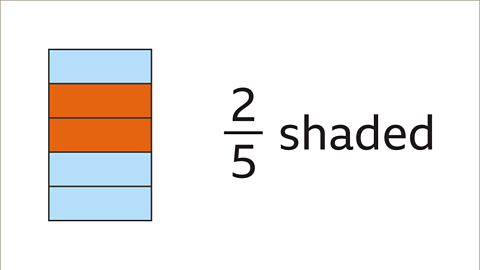
Image caption, Fractions can be shown by a diagram or written in numbers.
Image caption, The top number is the numerator and the bottom number is the denominator.
Image caption, 3тБД8 are shaded orange. 3 out of 8 equal parts are shaded. The numerator is 3. The denominator is 8
Image caption, 5тБД9 of the shape is shaded orange. 5 out of 9 equal parts are shaded.
Image caption, 4тБД9 of the shape is unshaded. 4 out of 9 equal parts are unshaded.
Image caption, The denominator gives the number of stars. The numerator gives the number of stars selected. The fraction of stars selected is 4тБД11
1 of 6
Fractions on a number line
- A fraction can be a specific value or measurement on a number line.
- A number line is split into regular intervalThe value between equally spaced markings on a number line. between two labelled values.
- The intervals represent equal amounts - these can be whole numbers or fractions.
How to find the size of an interval on a number line
Find the differenceThe numerical difference between two numbers is found by comparing the quantities. A difference is always a positive value. The difference between 3 and 5 is 2, the difference between 5 and 3 is 2 between the two given values on the number line.
Count the number of intervals between the two values.
Divide the difference by the number of intervals.
This gives you the size of the interval. Use this to complete the fraction labels on the number line.
Example: fractions on a number line
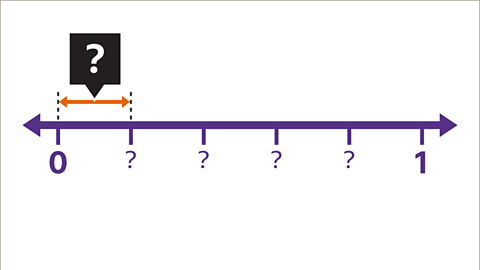
Image caption, Work out the size of each interval on the number line and the missing labels.
Image caption, To work out the size of an interval on the number line, start by finding the difference between the labelled values 0 and 1. The difference between 1 and 0 is 1
Image caption, Count the number of intervals. There are five intervals.
Image caption, Now divide the difference by the number of intervals. 1 divided by 5 is 1тБД5. Each interval is 1тБД5
Image caption, The number line increases in fifths, so count in fifths. 1тБД5 , 2тБД5, 3тБД5, 4тБД5, 5тБД5. Remember that 5тБД5 is the same as one whole.
1 of 5
Practise fractions
Activity: recognising fractions
Try this activity to practise recognising fractions.
Fractions quiz
Practise what you've learned about fractions with this quiz.
Real-world maths
Fractions are used in lots of places every day. For example, you use fractions when telling the time, measuring lengths and weighing ingredients.

- Fractions are used in food production.
Understanding equal parts is important when giving equal slices of cake or pie. Fractions are also important when measuring and weighing ingredients. If a recipe uses \( \frac{1}{4} \) of a teaspoon of salt, the taste would be very different if \( \frac{1}{2} \) a teaspoon was used.

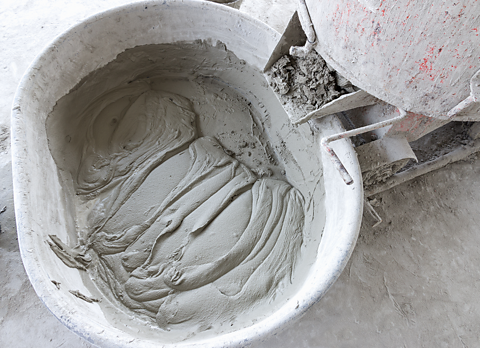
In construction, builders use fractions as a proportion of the whole for different building materials.
A concrete mix is 1 part cement, 2 parts sand and 4 parts aggregate - a rock-like material.
This means \( \frac{1}{7} \) of the mix is cement, \( \frac{2}{7} \) is sand and \( \frac{4}{7} \) is aggregate.

Game - Divided Islands
Play the Divided Islands game! gamePlay the Divided Islands game!
Using your maths skills, help to build bridges and bring light back to the islands in this free game from │╔╚╦┬█╠│ Bitesize.

More on Fractions
Find out more by working through a topic
- count2 of 14
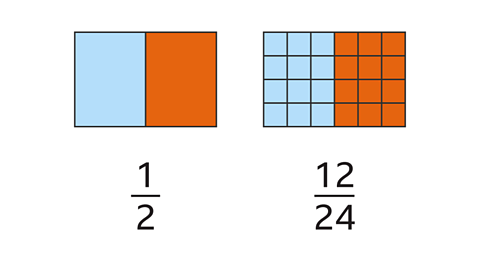
- count3 of 14
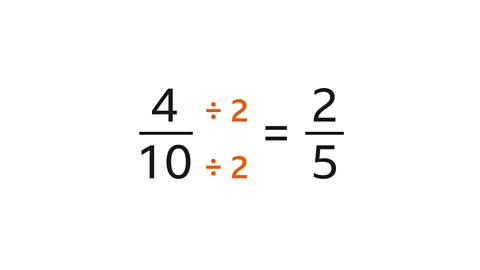
- count4 of 14
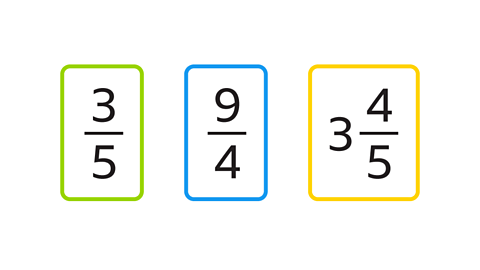
- count5 of 14
